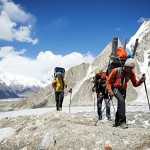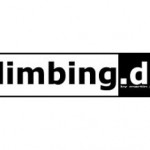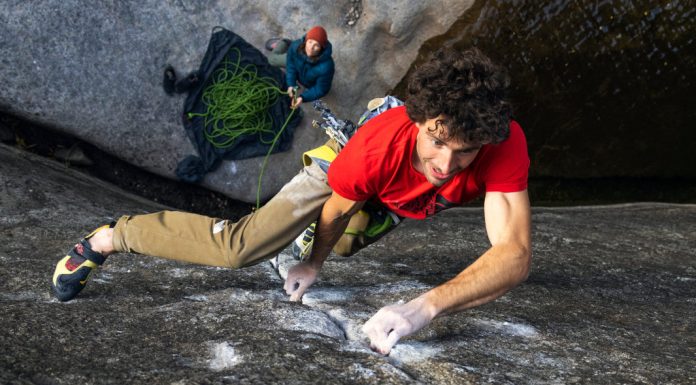Lucy Creamer on the first hard moves through the roof, Kalea Borroka, F8b+UKC News, 21 Apr 2009© Tim GlasbyLucy Creamer has succeeded on her hardest sport route to date and the hardest sport route climbed by a British woman.She spent most of the winter out in Spain, working her way through a long list of F8 graded routes (see UKC Newsflash), including several F8a onsights. Her trip culminated in a redpoint ascent of Kalea Borroka, F8b+.Kalea Borroka is a huge, 40m overhanging crack on perfect orange limestone at Siurana. The route has been described as “the best line in Spain”.Lucy's trip was plagued by bad weather and Kalea Borroka only dried out for short periods. When a sunny spell hit on the 5th of April, she knew that she had only one chance. The route was drying outnicely but the forecast was for more rain to come.The winter seemed to have been a season of extremes – one minute it was down jackets, hats and gloves and then it was too hot to climb!Lucy CreamerLucy warmed up on the route in the morning and, although it was still a little damp from the night before, she almost climbed it first go. Then – disaster. It went from rain to strong sun, too hot to climb. Lucy had to wait six hours for the temperature to drop before she could set off up one of the best lines in Spain.The first hard section felt a bit shaky but she got through it, and blasted up to the massive halfway rest. A toe hook in a pocket provided the respite needed to get ready for the powerful crimpy crux, with a match on a tiny edge.Feeling fully recovered Lucy set off. The holds up there felt drier than before and this provided an added boost to her confidence. She got into the crux feeling strong, made it to the match and for the first time slapped for the next hold. She held it.Clipping the belay was a great moment for many reasons, relief was a big one! Climbing an F8b+ had been a big goal but what made it even better was that the climbing on Kalea Borroka is so good and it's such a classic line.Lucy CreamerLucy Creamer making the hard match on a crimp, Kalea Borroka, F8b+UKC News, 21 Apr 2009© Tim GlasbyJack Geldard gets the full details in this UKC Interview:Jack: Congratulations on ticking F8b+! How did you work up to it, any specific planning?Lucy: I basically went climbing more! Having not done too much last year due to elbow injuries, work and lack of motivation, I was psyched over this winter and decided to get out on rock more, this meant travelling abroad.Jack: Was it a huge step up from F8b for you?Lucy: This particular route didn't feel like a huge step because it really suited my strengths but I tried other 8b+'s that had more burly moves on that would probably have taken me longer.Jack: That sounds pretty positive, so do you think you could do harder? Would you want to?Lucy: I'm pretty sure I could do harder if I stick with it and stay psyched, never as easy as it sounds. I am quite keen to try an F8c, so I might do some research and find one that is more my style. Although, I would absolutely love to do White Zombie in Baltzola, it looks totally amazing. Jack: Why Kalea Borroka? James McHaffie recently told me he thinks this route is one of the ultimate sport routes ? totally amazing. Would you agree with that?Lucy: James is right, it is totally awesome. Just standing on the ground and looking up gets my fingertips tingling. It's an immense overhanging crack that just screams 'climb me'! And then when you get on it, it's every bit as good as it looks. There are no utterly desperate moves but three hard sections between good rests. Jack: Where's the crux?Lucy: The crux is the last hard section, which suited me as I could totally recover before I got to it, utilising a toe hook in a pocket; no bat hangs for me! I would have to say KB is probably my perfect route apart from the fact it had condition issues.Jack: Yeah, it sounded extremely wet out there. That must have slowed you down on the route a bit. How many days did it take to redpoint?Lucy: I had one quick go up it in January when it was wet but properly got stuck into it at the end of March. I had four days working it. By the third day I was getting to the big rest easily and almost getting to the end of the crux but I hadn't actually climbed past this point (as there are no dogging bolts), so decided on my fourth day to focus on getting through the crux and making it to the belay! My fifth day on it I was redpointing but it was soaked. But I was so frustrated that I still wanted to climb it. Then I did it on my sixth day, 2nd go.Jack: That's pretty fast. Did it feel like you'd spent a lot of time on it, or did it feel like quite a fast ascent?Lucy: It felt like it went pretty quickly especially because on some of those days I'd only be having a couple of plays on it due to time and weather etc. When I started it I was prepared to put a lot more time into it if necessary, as I was very psyched for this route but fortunately it didn't turn out to be too much of a saga.Jack: How did you find being out in Spain for the winter?Lucy: I had a fantastic time overall. There were times that were really frustrating due to pretty grim weather conditions; in fact it was supposed to be the worst winter this area has had for 20 years. But I just kept telling myself that it can't be worse than England and at least I was climbing some amazing routes on rock, rather than training down the wall. I met some great people along the way and really enjoyed living in my van. I think I might find a shack in the country and live there, as I like being closer to nature than you can be in a city and being part of the changing seasons was really nice.Jack:Any words of advice for other climbers wanting to push their sport climbing?Lucy:As I always say, going climbing is one of the best ways; using what you've already got to it's best advantage. It's probably easier to push your redpoint grade by training your weaknesses indoors but improving onsighting comes down to mileage on rock, thinking quick and clever and being fit. These aren't so easy to train in the gym, as they are time consuming and are gained through experience. Redpointing can be a very effective way to move through the grades, especially for people who have limited time for training. Whereas onsighting is immensely satisfying, as the battle can be hard won but climbing harder might take a bit longer.Lucy would like to thank her sponsorsMarmot ,Scarpa andGrivel . Also Lyon Equipment for the extra longBeal 'Booster' rope needed for Kalea Borroka.UKClimbing.com would like to thank Lucy for taking the time to do this interview and also Tim Glasby for his excellent photographs. Diesen Artikel inkl. Bilder auf UKClimbing.com anschauen
- Home
- News
- Videos
- Fotos
- Klettergebiete
- Unternehmen & Produkte
- Themen
- Themen beginnend mit 0-9
- Themen beginnend mit A
- Themen beginnend mit B
- Themen beginnend mit C
- Themen beginnend mit D
- Themen beginnend mit E
- Themen beginnend mit F
- Themen beginnend mit G
- Themen beginnend mit H
- Themen beginnend mit I
- Themen beginnend mit J
- Themen beginnend mit K
- Themen beginnend mit L
- Themen beginnend mit M
- Themen beginnend mit N
- Themen beginnend mit O
- Themen beginnend mit P
- Themen beginnend mit Q
- Themen beginnend mit R
- Themen beginnend mit S
- Themen beginnend mit T
- Themen beginnend mit U
- Themen beginnend mit V
- Themen beginnend mit W
- Themen beginnend mit X
- Themen beginnend mit Y
- Themen beginnend mit Z
- Routendatenbank
Climbing.de ist eine der ältesten deutschsprachigen Bergsportseiten im Internet.
Seit 1998 präsentiert Inhaber Martin Joisten, dessen Texte und Bilder in zahlreichen nationalen und internationalen Publikationen zu finden sind, aktuelle Informationen aus der Welt des Bergsports.
Seit 1998 präsentiert Inhaber Martin Joisten, dessen Texte und Bilder in zahlreichen nationalen und internationalen Publikationen zu finden sind, aktuelle Informationen aus der Welt des Bergsports.
Kontaktieren Sie uns: info@climbing.de
© Copyright 1998 - 2022 Climbing.de by Martin Joisten


![[VIDEO] Alexander Megos: URSUS | The days after the send URSUS | The days after the send (c) Alexander Megos](https://www.climbing.de/wp-content/uploads/2024/03/youtube_WCZVR9-tZTc-218x150.jpg)

![[VIDEO] Stefano Ghisolfi: ALL my secrets about ENDURANCE Stefano Ghisolfi: ALL my secrets about ENDURANCE (c) Stefano Ghisolfi](https://www.climbing.de/wp-content/uploads/2024/03/youtube_xlQ2OreHL60-218x150.jpg)
![[VIDEO] THE FULL JOURNEY 9B FA by Alexander Megos THE FULL JOURNEY 9B FA by Alexander Megos (c) Alexander Megos](https://www.climbing.de/wp-content/uploads/2022/12/youtube_QwjykRehg7M-218x150.jpg)
![[VIDEO] MEGATRON V17 MEGATRON V17 (c) mellow](https://www.climbing.de/wp-content/uploads/2022/12/youtube_f_MniTA8MYU-218x150.jpg)
![[VIDEO] Moulin Rouge (7b) Free Solo | Jonas Hainz Moulin Rouge - Free Solo (c) Jonas Hainz](https://www.climbing.de/wp-content/uploads/2022/10/youtube_UQs4KNRBHss-218x150.jpg)
![[VIDEO] IFSC Worldchampionship Bouldern Munich 2014 Saturday Semi Recap](https://www.climbing.de/wp-content/uploads/2014/12/vimeo_104175958-150x150.jpg)

![[VIDEO] Rocklands with Mina Leslie-Wujastyk (Part 4)](https://www.climbing.de/wp-content/uploads/2014/12/vimeo_93052230-150x150.jpg)









